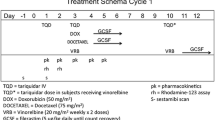Abstract
Purpose: Expression of P-glycoprotein (Pgp), which confers the multidrug resistance (MDR) phenotype, is thought to contribute to the insensitivity of renal cell cancer (RCC) to chemotherapy. The development of Pgp inhibitors for clinical application has been hampered by unacceptable toxicity at doses required to achieve adequate cellular concentration. Toremifene is able to reverse MDR and sensitise RCC to vinblastine in vitro. However, in vivo toremifene is tightly bound to serum proteins, in particular the acute phase protein α1-acid glycoprotein (AAG), which may limit tissue availability. In this phase I–II study we assessed the tolerability of short courses of high dose toremifene in combination with vinblastine and evaluated the key determinants of MDR reversal in vivo. Methods: Twenty-seven patients with metastatic RCC received escalating doses of oral toremifene for 3 days every 2 weeks in combination with vinblastine 6 mg/m2 i.v. on day 3 of each cycle. The serum concentration of toremifene, its metabolites and AAG were measured and the effect of patients' serum on inhibition of Pgp in vitro was determined. Results: Twenty-six patients were evaluable for response. Eight patients (31%) had stable disease and 18 patients (69%) progressive disease. The mean serum concentration of toremifene at 780 mg daily for 3 days was 7.82 μM [standard deviation (SD) 2.48, range 2.50 to 14.70], which exceeds that known to reverse MDR in vitro. The serum concentration of the major metabolite of toremifene, N-demethyltoremifene, which also reverses MDR, was 5.13 μM (SD 1.78, range 1.80 to 9.00). In 60% of patients the pre-treatment AAG concentration was above that known to block the effects of toremifene in vitro. However, addition of serum from patients on toremifene to MCF-7 adr cells in vitro inhibited Pgp-mediated efflux of rhodamine 123. Conclusions: We have shown that short course, high-dose toremifene in combination with vinblastine is generally well tolerated and that the concentration of toremifene required to reverse MDR in vitro is achievable in vivo.
Similar content being viewed by others
Author information
Authors and Affiliations
Additional information
Received: 7 July 1999 / Accepted: 15 November 1999
Rights and permissions
About this article
Cite this article
Braybrooke, J., Vallis, K., Houlbrook, S. et al. Evaluation of toremifene for reversal of multidrug resistance in renal cell cancer patients treated with vinblastine. Cancer Chemother Pharmacol 46, 27–34 (2000). https://doi.org/10.1007/s002809900085
Issue Date:
DOI: https://doi.org/10.1007/s002809900085




